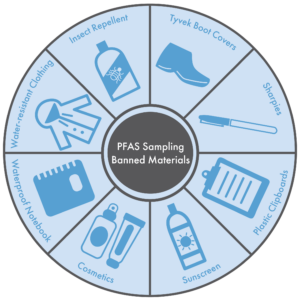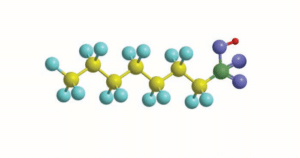Contributed by Joe Patrick, Senior Project Manager, PPM Consultants
With all the talk about PFOA/PFOS – how are we going to ensure accurate data collection when we are analyzing the contaminants to a parts per trillion detection level? This low quantification limit requires care in all aspects of the sample collection process including sample kit preparation, transport and collection. Because of these concerns and the possible submittal of results to regulatory agencies, PFOA sampling requires careful consideration.
 On March 8, 2024, EPA published a final rule designating perfluorooctanoic acid (PFOA) and perfluorooctaneosulfonic acid (PFOS) as CERCLA Hazardous Substances. In these regulations, EPA also published a Strategic Roadmap for PFAS/PFOS as a comprehensive framework outlining the U.S. Environmental Protection Agency’s (EPA) approach to address the environmental and public health concerns posed by these chemicals. The listing under CERCLA also allows EPA to more quickly address assessment/remediation and also to conduct cost recovery.
On March 8, 2024, EPA published a final rule designating perfluorooctanoic acid (PFOA) and perfluorooctaneosulfonic acid (PFOS) as CERCLA Hazardous Substances. In these regulations, EPA also published a Strategic Roadmap for PFAS/PFOS as a comprehensive framework outlining the U.S. Environmental Protection Agency’s (EPA) approach to address the environmental and public health concerns posed by these chemicals. The listing under CERCLA also allows EPA to more quickly address assessment/remediation and also to conduct cost recovery.
PFOAs/PFOS have been produced and used since the 1940s and due to their popularity and widespread use, they are ubiquitous worldwide; it is postulated that most humans and wildlife contain some level of PFOAs and PFOS in their blood. Historically, these compounds have been widely used in consumer products including carpets, personal care products (dental floss, makeup, cosmetics, shampoo, sunscreen), clothing, furniture fabrics, food packaging, non-stick cookware, and many industrial processes. Fluorine is the most electronegative element on the periodic table, and when fluorine combines with carbon it forms a very stable chemical. This is why they are referred to collectively as “forever chemicals”.
The PFOAs/PFOS compounds are also known to bioaccumulate in humans and cause cancer. They were identified by EPA via the Unregulated Contaminate Monitoring Rule where unregulated chemicals are monitored to see if they are present in drinking water. When detected, EPA then identifies the occurrence and then evaluates how the chemicals (and generators) will be regulated. In short, EPA has identified PFOAs/PFOS as hazardous substances, and the next step is to identify how they are distributed in soil, air and water.
EPAs strategic roadmap serves as a blueprint for the agency’s actions over the next few years and it is structured around three primary goals:
- Research and Innovation
- Regulation and Enforcement
- Remediation and Cleanup
Step 1 of the roadmap is on-going and in April of 2024, EPA has already determined that the compounds are hazardous and has established MCLs for drinking water.
Step 2 is also being initiated. EPA’s Strategic Roadmap as well as the Code of Federal Regulation has documented a focus on certain industrial groups in an effort to understand where the worst exposures are. This step will involve identification of PFOAs/PFOS in the following industrial groups:
- Manufacturers of PFOAs/PFOS
- Processors of PFOAs/PFOS
- Manufacturers of products that contain PFOAs/PFOS
- Downstream Users of PFOAs/PFOS products
- Waste Management facilities
- Wastewater Treatment Facilities (POTWs)
 The widespread use and distribution of these compounds will require that different sampling and analytical methods be used for their assessment. The designation of these compounds as Hazardous Substances under CERCLA gives EPA the flexibility to create efficient recovery/remediations of COC’s as well as a mechanism for cost recovery from responsible parties (as applicable under CERCLA). This initiative is very far reaching. While it will obviously have a strong impact on Publicly Owned Treatment Works (POTW) discharging under the authority of a State-directed NPDES permit, it will most certainly also impact the countless industrial indirect (pretreatment) dischargers that direct the effluent to the POTW’s. Those indirect discharges directly impact what the POTW’s are having to treat.
The widespread use and distribution of these compounds will require that different sampling and analytical methods be used for their assessment. The designation of these compounds as Hazardous Substances under CERCLA gives EPA the flexibility to create efficient recovery/remediations of COC’s as well as a mechanism for cost recovery from responsible parties (as applicable under CERCLA). This initiative is very far reaching. While it will obviously have a strong impact on Publicly Owned Treatment Works (POTW) discharging under the authority of a State-directed NPDES permit, it will most certainly also impact the countless industrial indirect (pretreatment) dischargers that direct the effluent to the POTW’s. Those indirect discharges directly impact what the POTW’s are having to treat.
New NPDES and Pretreatment permits being released are already including PFOA/PFOS and GEN-X compounds as a parameter for monitoring only. Data is being gathered by state and local stakeholders to determine the path forward.
For these reasons, it is important that when industries are requested to include PFOAs/PFOS in their sampling programs, that they develop a thorough and defensive sampling protocol. The accuracy of sampling data will have a significant impact on determining if the industry is a source of PFOA/PFOS contamination. The widespread use of PFOAs/PFOS and the low MCL’s (4 parts per trillion) will require thorough consideration of sampling protocols to ensure quality data produced by the sampling team that is both accurate and defensible. It will be a considerably more intense than for conventional pollutants.
Conventional sampling protocol entailed latex gloves for personal protective equipment (PPE) as well as careful consideration of cross contamination, detailed decontamination of equipment, and of course to limit their own exposure to contamination. With PFOA/PFOSs, this protocol will be heightened considerably due to the extremely low detection limits and the prevalence of those constituents in so many parts of everyday life. A few examples of sampling protocol differences include:
- No write-in-the rain field books
- No bold point Sharpie pens allowed
- Sample labels are completed and applied to container after sample collection
- Certain Insect repellant and Sunscreens should not be worn
- Samplers advised to establish “exclusion zones” for visitors at sample sites
- Samplers should shower the night before and omit the use of personal care items (lotions, makeup, perfumes) unless medically necessary
- Footwear should not be Gore-Tex or be treated with water repellant chemicals
- No Teflon® sampling equipment and/or other fluoropolymer-containing materials (e.g., polyvinylidene fluoride [PVDF], Kynar®, Neoflon®, Tefzel®
- No glass sample containers with teflon lids
- No reusable (blue ice) ice packs
- Avoid or omit post-it notes
- The lab should provide prepacked “PFAS-free” water samples.
- Two-person sampling teams are highly recommended to ensure minimization of cross contamination by separating sampling and documentation efforts.
EPA Region 9 developed a detailed sampling protocol that can be viewed here.
We never really touched on Step 3 – I would venture to say that it has barely been initiated short of some voluntary data collection or litigation. It appears to be a freight train coming. All this said, it will be very interesting to see what the effects of the new Trump administration will have on EPA’s PFAS Strategic Roadmap! I feel certain there will likely be some drama surrounding this regulatory initiative. Stay tuned!
PPM Consultants are ready and able to assist you with our team of professionals in the event you have a PFAS/PFOA related issue that you need assistance with. Feel free to reach out to me directly at joe.patrick@ppmco.com.

